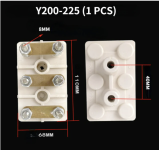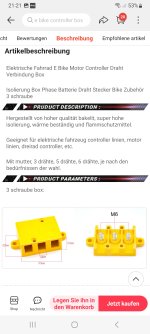dragon
1 W
Please bear with another question from a newbie:
I have on order a qs motor 17x3.5" 5000w hub motor & I want to put in-line quick disconnects to facilitate future rear tire changes & make towing with a motorcycle tow dolly electrically safer.
Which connectors would best be able to handle the phase wire connections of a 5000w motor? My controller will be a ND72680.
I feel more comfortable with mechanical crimp connections than soldered ones so originally I was planning to crimp heavy duty ring terminals & use one of those yellow junction boxes or encase the terminals in a tiny aluminum box/case.
Alternatively would mt60 connectors be able to handle the current? How about XT90’s or XT150’s
Another crazy thought I had was to use a 3-pole circuit breaker.
Any suggestions from the electrical gurus on here?
I have on order a qs motor 17x3.5" 5000w hub motor & I want to put in-line quick disconnects to facilitate future rear tire changes & make towing with a motorcycle tow dolly electrically safer.
Which connectors would best be able to handle the phase wire connections of a 5000w motor? My controller will be a ND72680.
I feel more comfortable with mechanical crimp connections than soldered ones so originally I was planning to crimp heavy duty ring terminals & use one of those yellow junction boxes or encase the terminals in a tiny aluminum box/case.
Alternatively would mt60 connectors be able to handle the current? How about XT90’s or XT150’s
Another crazy thought I had was to use a 3-pole circuit breaker.
Any suggestions from the electrical gurus on here?




